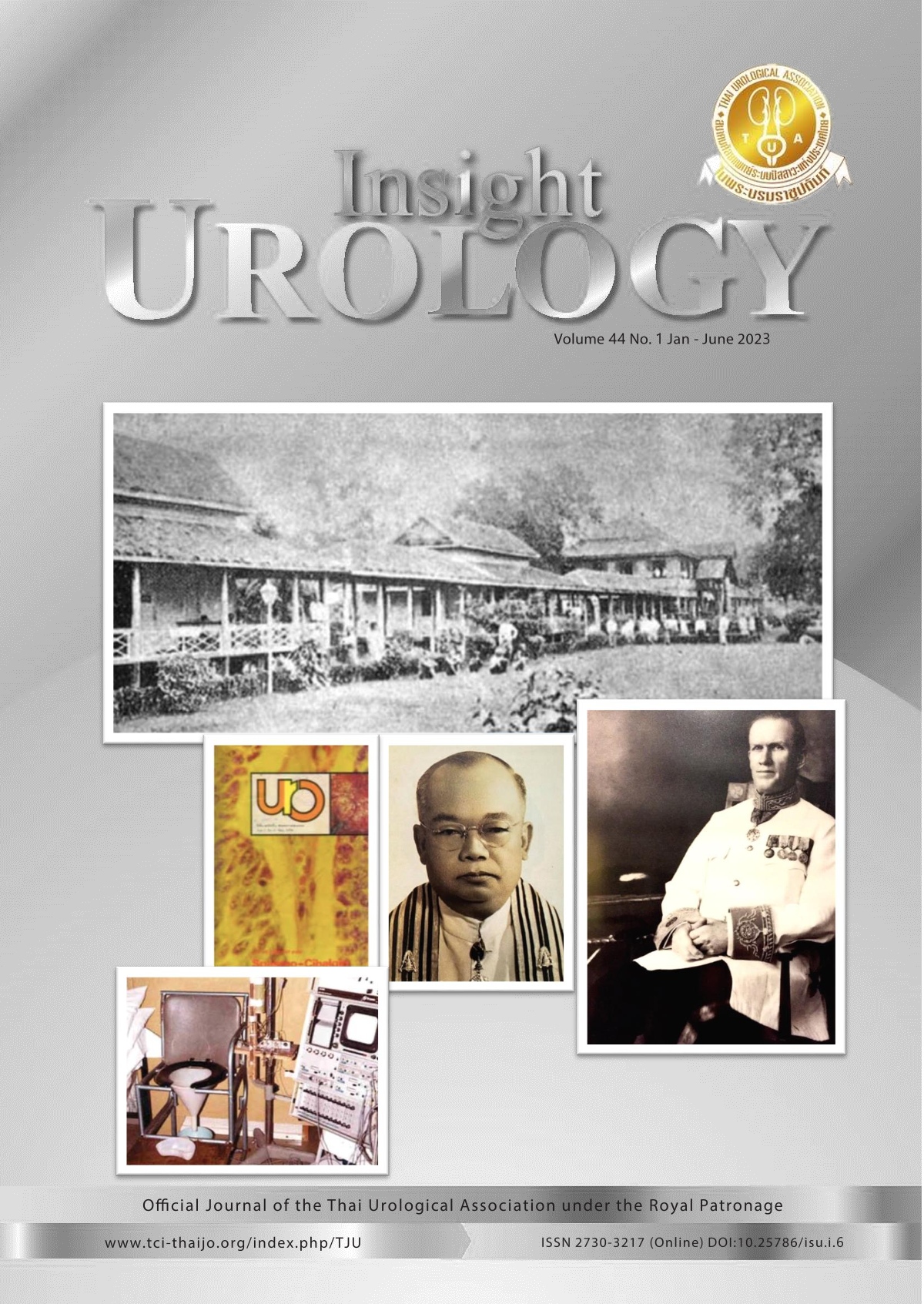Comparison of the quality of life between ileal conduit and orthotopic neobladder in post radical cystectomy bladder cancer male patients using the FACT-BL questionnaire
DOI:
https://doi.org/10.52786/isu.a.69Keywords:
Urinary diversion, bladder cancer, quality of life, FACT-BLAbstract
Objective: Radical cystectomy (RC) is standard treatment for bladder cancer. Removal of the bladder requires reconstruction of the lower urinary tract, a procedure that also has impact on the patient’s quality of life (QoL). In Thailand, information pertinent to the level of the quality of life between ileal conduit and orthotopic neobladder is still limited. The objectives of this study are to evaluate the quality of life (primary outcome) and oncologic outcome (secondary outcome) of patients who underwent an Ileal Conduit (IC) or Orthotopic Neobladder (NB) using FACT-BL, a bladder-cancer-specific questionnaire.
Materials and Methods: One hundred and forty six patients underwent radical cystectomy and urinary diversion for bladder cancer from 2009 to 2019 at our institution. Out of these, 61 (42%) patients were asked to participate in this study. All 61, who were divided into two groups, 34 IC and 27 NB, completed the ques- tionnaire, a survey response rate of 100%. Mean follow-up was 7 years 3 months.
Results: There were no statistically significant differences in ll FACT-G categories (PWB, SWB, EWB and FWB) between the two groups. Patients with neobladder had reported that they urinated more frequently than usual. Mean interest in sex was 49% in all patients and capability of maintaining an erection was 23%. The mean total values of FACT-BL in IC and NB patients were 128.51 ± 15.51 and 126.70 ± 17.35, showing no significant difference.
Conclusion: Prinary diversion type does not appear to be associated with differential post-operative QoL and sexual satisfaction. There is a possibility that patients with neobladder urinate more frequently than before surgery but this did not reach statistical significance.
References
Bray F, Ferlay J, Soerjomataram I, Siegel RL, Torre LA, Jemal A. Global cancer statistics 2018: GLOBOCAN estimates of incidence and mortality worldwide for 36 cancers in 185 countries. CA Cancer J Clin 2018;68:394-424.
NCCN guidelines version 1.2022 bladder cancer [Internet]. [cited 2022 February 22]. Available from: http://www.nccn.org/ professionals/physician_gls/ pdf/bladder.pdf
Ghosh A, Somani BK. Recent trends in postcystectomy health-related quality of life (QoL) favors neobladder diversion: Systematic review of the literature. Urology 2016;93:22-6.
Singh V, Yadav R, Sinha RJ, Gupta DK. Prospective comparison of quality-of-life outcomes between ileal conduit urinary diversion and orthotopic neobladder reconstruction after radical cystectomy: A statistical model. BJU Int 2014;113:726-32.
Cella DF, Tulsky DS, Gray G, Sarafian B, Linn E, Bonomi A, et al. The functional assessment of cancer therapy scale: development and validation of the general measure. J Clin Oncol 1993;11:570-9.
Mansson A, Davidsson T, Hunt S, Mansson W. The quality of life in men after radical cystectomy with a continent cutaneous diversion or orthotopic bladder substitution: is there a difference? BJU Int 2002;90:386-90.
Elbadry MS, Ali AI, Hassan A, Clement KD, Hammady AR, Abdbelaal A, et al. The relationship between type of urinary diversion and quality of life after radical cystectomy: Ileal conduit versus orthotopic bladder. BJUI Compass 2020;1:133-8.
Dutta SC, Chang SC, Coffey CS, Smith JA, Jr., Jack G, Cookson MS. Health related quality of life assessment after radical cystectomy: comparison of ileal conduit with continent orthotopic neobladder. J Urol 2002;168:164-7.
Steers WD. Voiding dysfunction in the orthotopic neobladder. World J Urol 2000;18:330-7.
Bjerre BD, Johansen C, Steven K. Health-related quality of life after cystectomy: bladder substitution compared with ileal conduit diversion. A questionnaire survey. Br J Urol 1995;75:200-5.
Kikuchi E, Horiguchi Y, Nakashima J, Ohigashi T, Oya M, Nakagawa K, et al. Assessment of Long-term quality of life using the FACT-BL questionnaire in patients with an ileal conduit, continent reservoir, or orthotopic neobladder. Jpn J Clin Oncol 2006; 36:712-6.
Modh R, Mulhall J, Gilbert S. Sexual dysfunction after cystectomy and urinary diversion. Nat Rev Urol 2014;11:445-53.
Nayak A, Cagiannos I, Lavallée L, Morash C, Hickling D, Mallick R, et al. Urinary function following radical cystectomy and orthotopic neobladder urinary reconstruction. Can Urol Assoc J 2018;12:181-6.
Ghodoussipour S, Ladi S, Jiang D, Lifton J, Ahmadi H, Wayne K, et al. Predictors of need for catheterisation and urinary retention after radical cystectomy and orthotopic neobladder in male patients. BJU Int 2021;128:304-10.
Gacci M, Saleh O, Cai T, Gore JL, D’Elia C, Minervini A, et al. Quality of life in women undergoing urinary diversion for bladder cancer: results of a multicenter study among long-term disease-free survivors. Health Qual Life Outcomes 2013;11:43.
Downloads
Published
How to Cite
Issue
Section
License
Copyright (c) 2023 Insight Urology

This work is licensed under a Creative Commons Attribution-NonCommercial-NoDerivatives 4.0 International License.



